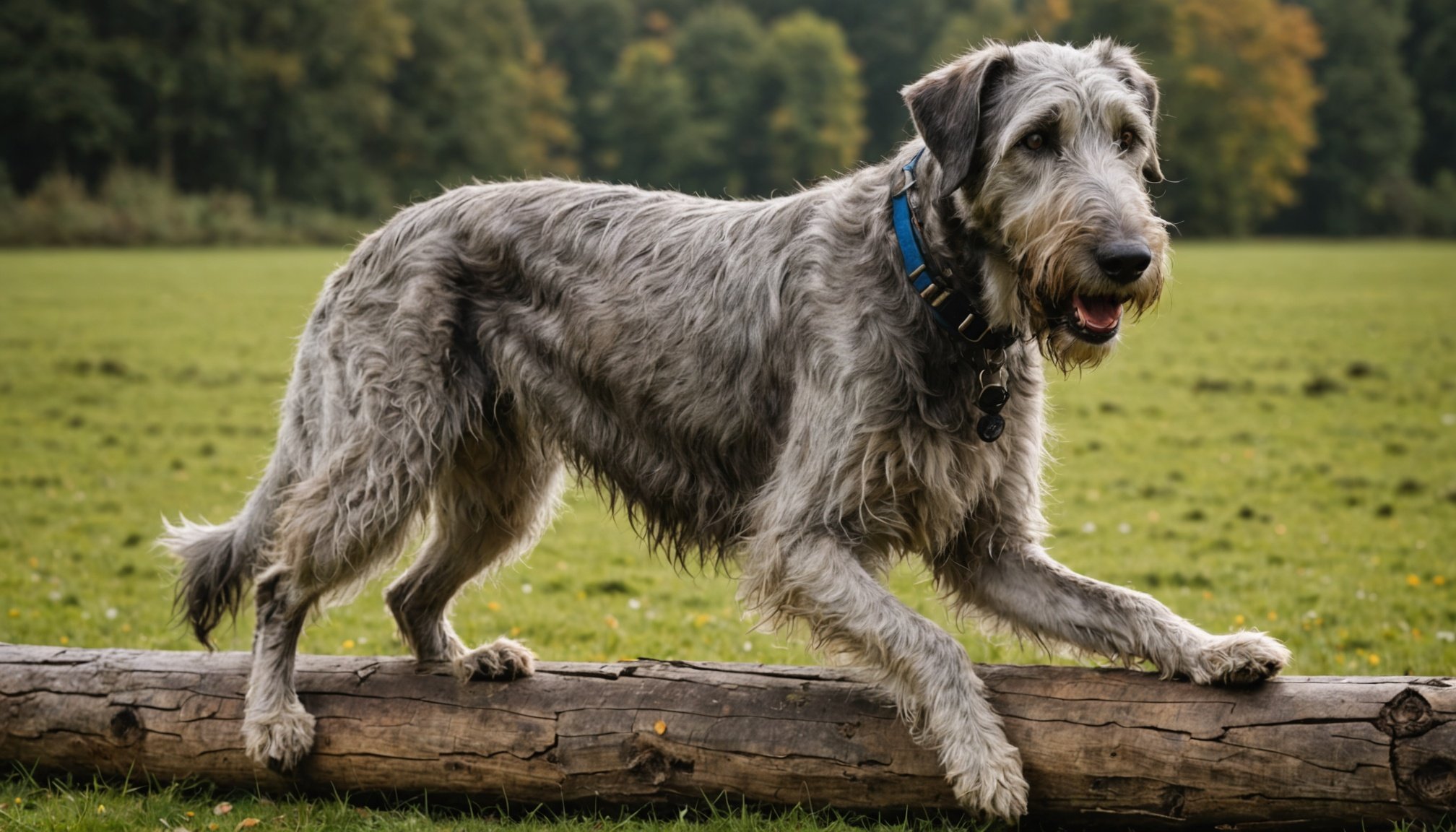Preparing Your Irish Wolfhound for Thrilling Long-Distance Adventures
If you’re an avid outdoor enthusiast and the proud owner of an Irish Wolfhound, you’re likely eager to share your love for long-distance adventures with your loyal companion. Irish Wolfhounds, with their majestic stature and gentle nature, can make excellent hiking and running partners, but they require careful preparation and care to ensure their safety and well-being.
Understanding Your Irish Wolfhound’s Needs
Before embarking on any long-distance adventure, it’s crucial to understand the unique needs and characteristics of the Irish Wolfhound breed.
Also to read : Mastering the art of administering oral medications to your stubborn shiba inu: a comprehensive pet owner”s guide
Physical Characteristics and Health
Irish Wolfhounds are one of the tallest dog breeds, with males reaching heights of at least 32 inches and weighing up to 120 pounds, while females are slightly smaller[2][3].
- Life Expectancy: Irish Wolfhounds have a relatively short life expectancy of 6 to 8 years, which makes every adventure precious.
- Health Issues: They are prone to joint issues, heart problems, and certain types of cancer. Therefore, it’s essential to monitor their health closely and avoid excessive strain on their joints, especially during their growth stages[2][3].
Exercise and Activity Level
Irish Wolfhounds need regular exercise to stay healthy, but their exercise needs are moderate compared to other high-energy breeds.
Also read : What are the signs that my dog may be bored, and how can I keep them entertained?
- Daily Exercise: Aim for 1 to 2 hours of exercise per day, which can include walks, gentle jogs, and free play in a securely fenced area. Avoid excessive exercise, especially during their growth stages, to prevent joint damage[1][2][3].
- Growth Stages: Puppies should not be subjected to strenuous exercise until they are at least 16 to 18 months old. This allows their bones and joints to mature properly[1][3].
Training Your Irish Wolfhound
Training is a critical component of preparing your Irish Wolfhound for long-distance adventures. Here’s how you can get started:
Early Training and Socialization
- Start Early: Training should begin when your Irish Wolfhound is still a puppy. This is crucial for instilling good behaviors and manners.
- Positive Reinforcement: Use positive reinforcement techniques such as treats, toys, and praise to encourage good behavior. Irish Wolfhounds are intelligent but can be independent, so consistency and patience are key[1][2][3].
Basic Obedience Commands
Teaching basic obedience commands is essential for any dog, especially a breed as large and powerful as the Irish Wolfhound.
- Commands: Focus on commands like “sit,” “stay,” “come,” and “walk nicely on a leash.” These commands will help you maintain control during your adventures.
- Socialization: Socialize your puppy extensively to new people, situations, and other animals. This helps them become confident and calm in new environments[1][2][4].
Grooming and Health Maintenance
Grooming and health maintenance are vital to ensure your Irish Wolfhound remains healthy and comfortable during long-distance adventures.
Coat Care
- Double Coat: Irish Wolfhounds have a double coat with a soft undercoat and a wiry overcoat. They shed lightly all year round but require regular brushing to prevent matting.
- Brushing: Use a rake brush to prevent tangling and a pin brush to keep their coat healthy. Brush at least weekly and hand-strip the coat every six months[1][2][3].
Dental Care
- Daily Brushing: Brush your dog’s teeth daily to prevent dental issues. Start this habit early to get your puppy accustomed to the process.
- Nail Care: Trim their nails every four to six weeks, and check their ears weekly for any dirt or irritation[1][2].
Diet and Nutrition
A balanced diet is crucial for maintaining your Irish Wolfhound’s health and energy levels.
- High-Quality Food: Feed a high-quality commercial dog food specifically formulated for large breeds. Consult your vet to determine the best diet based on your dog’s age, activity level, and other factors.
- Avoid Overweight: Be mindful of treats and extra food to prevent overweight, which can stress their joints and lead to heart issues[1][2][3].
Preparing for Long-Distance Adventures
Once your Irish Wolfhound is well-trained, groomed, and healthy, it’s time to prepare for those thrilling long-distance adventures.
Choosing the Right Gear
- Harnesses and Leashes: Use a comfortable harness and a sturdy leash. For strong dogs, body harnesses can be a great option to ensure better control[4].
- Water and Snacks: Always carry fresh water and healthy snacks to keep your dog hydrated and energized.
- First Aid Kit: Pack a canine first aid kit with essentials like bandages, antiseptic wipes, and any medications your dog might need.
Selecting Dog-Friendly Trails
- Fenced Areas: Opt for trails with fenced areas where your dog can run freely without the risk of escaping or encountering wildlife.
- Terrain: Choose trails with varied terrain to keep your dog engaged and exercised. However, avoid trails with steep inclines or rough terrain that could strain their joints[2][3].
Tips for a Successful Wolfhound Adventure
Here are some practical tips to ensure a successful and enjoyable adventure with your Irish Wolfhound:
Start Slowly
- Gradual Increase: Gradually increase the distance and intensity of your walks and hikes to allow your dog to acclimate.
- Listen to Your Dog: Pay attention to your dog’s signals. If they seem tired or uncomfortable, it’s time to head back.
Stay Hydrated and Fed
- Regular Breaks: Take regular breaks to give your dog water and snacks.
- Monitor Weather: Avoid hiking during extreme weather conditions. Irish Wolfhounds can be sensitive to heat and cold.
Keep Them Engaged
- Mental Stimulation: Incorporate activities that provide mental stimulation, such as scent games or agility training, to keep your dog engaged and happy.
- Social Interactions: Allow your dog to interact with other dogs and people to maintain their social skills.
Real-Life Examples and Anecdotes
A Day in the Life of an Irish Wolfhound Owner
“I remember the first time I took my Irish Wolfhound, Finn, on a long hike. He was about a year old and full of energy. We started with a short trail and gradually increased the distance over the next few weeks. Finn loved the freedom of running in the open fields and the attention he got from other hikers. However, I quickly learned to watch for signs of fatigue and to keep him hydrated. Now, Finn is my constant companion on all my outdoor adventures, and I couldn’t imagine exploring without him.”
Overcoming Challenges
“One of the biggest challenges I faced was managing Finn’s prey drive. As a sighthound, he has a strong instinct to chase small animals. To overcome this, I ensured he was always on a leash during walks and trained him to respond to the ‘come’ command immediately. It took patience and consistency, but now Finn is much better at ignoring distractions and staying by my side.”
Preparing your Irish Wolfhound for long-distance adventures is a rewarding experience that requires careful planning, consistent training, and a deep understanding of the breed’s unique needs. By following these guidelines, you can ensure that both you and your dog have a safe, enjoyable, and thrilling experience exploring the great outdoors together.
Practical Insights and Actionable Advice
Here are some key takeaways to keep in mind as you prepare your Irish Wolfhound for long-distance adventures:
Training Checklist
- Start training early
- Use positive reinforcement
- Focus on basic obedience commands
- Socialize extensively
- Gradually increase exercise intensity
Grooming Checklist
- Brush weekly to prevent matting
- Hand-strip the coat every six months
- Trim nails every four to six weeks
- Brush teeth daily
Diet and Nutrition Checklist
- Feed high-quality commercial dog food
- Consult your vet for the best diet plan
- Avoid overfeeding to prevent overweight
- Use puzzle toys to prevent bloat
Adventure Preparation Checklist
- Choose dog-friendly trails
- Pack essential gear like harnesses, leashes, water, and snacks
- Take regular breaks for hydration and rest
- Monitor weather conditions
By following these checklists and tips, you can ensure that your Irish Wolfhound is well-prepared for any long-distance adventure, making every outing a joyous and memorable experience for both of you.
Table: Comparison of Exercise Needs for Different Breeds
| Breed | Exercise Needs | Ideal Activities | Special Considerations |
|---|---|---|---|
| Irish Wolfhound | Moderate | Walks, gentle jogs, free play | Avoid excessive exercise during growth stages; need regular breaks |
| Golden Retriever | High | Running, swimming, agility | Need consistent mental and physical stimulation |
| Terrier | Medium | Short walks, playtime | May require more frequent breaks due to smaller size and potential health issues |
| Labrador Retriever | High | Running, hiking, swimming | Need regular exercise to maintain weight and mental health |
Quotes from Experienced Owners
- “Irish Wolfhounds are not just pets; they are companions. With the right training and care, they can be your best friend on any adventure.” – Sarah, Irish Wolfhound owner
- “The key to a successful hike with an Irish Wolfhound is patience and consistency. They need time to adjust to new environments and commands.” – John, experienced dog owner
- “Irish Wolfhounds are gentle giants, but they require careful handling. Their size and strength demand respect and proper training.” – Emily, dog trainer
By understanding and addressing the specific needs of your Irish Wolfhound, you can create a lifelong bond built on trust, respect, and the joy of shared adventures. Happy trails









